

Welcome to Test yourself? Test My Brain. Perceptions of Sexual Attractiveness. Thank you for your interest in my online-study!
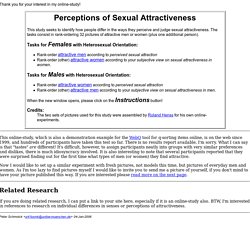
This online-study, which is also a demonstration example for the WebQ tool for q-sorting items online, is on the web since 1999, and hundreds of participants have taken this test so far. There is no results report available, I'm sorry. What I can say is that "tastes" are different! It's difficult, however, to assign participants neatly into groups with very similar preferences and dislikes, there is much idiosyncracy involved. It is also interesting to note that several participants reported that they were surprised finding out for the first time what types of men (or women) they find attractive. Now I would like to set up a similar experiment with fresh pictures, not models this time, but pictures of everyday men and women. If you are doing related research, I can put a link to your site here, especially if it is an online-study also. Treatment for the 'untreatable' Up to 30 percent of people who require mental health services have at least one personality disorder (PD)--characterized by abnormal and maladaptive inner experience and behavior.

Personality disorders, also known as Axis II disorders, include obsessive-compulsive PD, avoidant PD, paranoid PD and borderline PD. Axis I disorders, on the other hand, include depression and schizophrenia--mental illnesses thought to be less pervasive but more acute. While people with PDs can possess very different personality disturbances, they have at least one thing in common: chances are their mental illness will not remit without professional intervention.
I Am Unique. Analytical/Intuitive Thinking: PART IV, Patience. Types of Thinking Test: Concrete, Analytical, Abstract, Logical, Imaginative, Creative. This test analyzes five types of thinking: concrete (The Doer), analytical or abstract thinking (The Analyst), logical thinking (The Orator), imaginative (The Inventor) and creative (The Original Thinker).
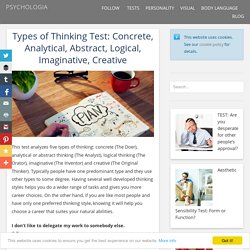
Typically people have one predominant type and they use other types to some degree. Having several well developed thinking styles helps you do a wider range of tasks and gives you more career choices. On the other hand, if you are like most people and have only one preferred thinking style, knowing it will help you choose a career that suites your natural abilities. I don’t like to delegate my work to somebody else. True False I would like to learn programming. I love reading books.
I am interested in arts. I always look for new ways to improve things. I am a visual learner. I enjoy playing chess. I find it easy to express myself; words come easy to me. I am highly imaginative. I like planning. I enjoy crafts. I used to make up new languages and secret codes as a child. Related Posts: PsnBig5_Mccrae03. T-shaped People: Deduction, Induction, Abduction and Systems Thinking. ← Is Conscious Capitalism A Conceptual Mess?
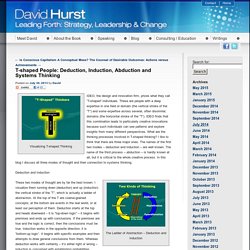
The Counsel of Desirable Outcomes: Actions versus Achievements → Visualizing T-shaped Thinking IDEO, the design and innovation firm, prizes what they call “T-shaped” individuals. These are people with a deep expertise in one field or domain (the vertical stroke of the “T”) and some expertise across several, often dissimilar, domains (the horizontal stroke of the “T”). IDEO finds that this combination leads to particularly creative innovations because such individuals can see patterns and explore insights from many different perspectives. Deduction and Induction The Ladder of Abstraction – Deduction and Induction. Thales_sakamoto's Profile.
What Kind of Introvert Are You? - Beautiful Minds - Scientific American Blog Network. Are you an introvert?
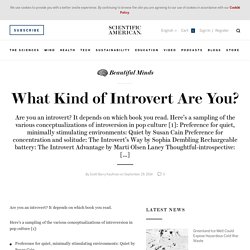
It depends on which book you read. Here's a sampling of the various conceptualizations of introversion in pop culture [1]: Preference for quiet, minimally stimulating environments: Quiet by Susan Cain Preference for concentration and solitude: The Introvert's Way by Sophia Dembling Rechargeable battery: The Introvert Advantage by Marti Olsen Laney Thoughtful-introspective: Solitude by A.
Storr Shy-socially anxious: The Gift of Shyness by A. Avila Artistic-sensitive-creative: The Highly Sensitive Person by E. Historically, there has been just as much confusion in the psychological literature. In the 60s Patricia Carrigan echoed this point, arguing that introversion was not effectively captured by a single scale. All seemed to be settled in the 90s with the emergence of the "Big Five" framework of personality.
Closer look at Introvert Intuition. Whatever types we happen to be, we use all four means of perception in one way or another.
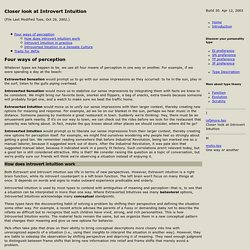
For example, if we were spending a day at the beach: Extraverted Sensation would prompt us to go with our sense impressions as they occurred: to lie in the sun, play in the surf, listen to the gulls piping overhead. Introverted Sensation would move us to stabilize our sense impressions by integrating them with facts we knew to be consistent. We might bring our favorite book, snorkel and flippers, a bag of snacks, extra towels because someone will probably forget one, and a watch to make sure we beat the traffic home.
Extraverted Intuition would move us to unify our sense impressions with their larger context, thereby creating new options for meaning and response. Introverted Intuition would prompt us to liberate our sense impressions from their larger context, thereby creating new options for perception itself. How Do You See Color? 5 Fun Online Color Quizzes. 4 Mind-Blowing Personality Tests Pictures. 1.
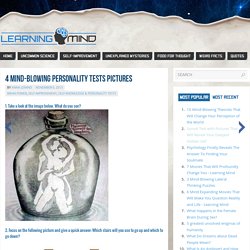
Take a look at the image below.